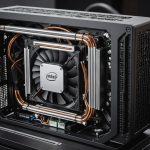In today’s digital era, optimizing your gaming hardware’s performance is not just desirable—it’s essential. With gaming systems becoming increasingly complex, maintaining peak performance goes hand-in-hand with understanding the intricate details of your hardware. Whether you’re a professional gamer or an occasional enthusiast, knowing how your CPU, GPU, and other components are performing can be the key to achieving the best frame rates and gameplay experiences. This article delves into the indispensable world of software tools that can help you monitor and enhance your gaming hardware’s performance, ensuring you remain at the top of your game.
The Role of Monitoring Software in Gaming
Navigating the World of Gaming Hardware
When you invest in a high-performance gaming setup, the expectations are high. You want seamless gameplay, crisp graphics, and efficient system performance. This is where monitoring software comes into play. It serves as a window into how well your hardware components like the GPU and CPU are operating. Understanding these metrics can help you make informed decisions about potential upgrades or adjustments to your system.
In the same genre : What are the differences between SSD and HDD when it comes to gaming?
Essential Metrics to Monitor
Monitoring software can provide insights into various aspects of your gaming hardware.
- GPU Performance: As one of the most critical components for gaming, the GPU’s health and efficiency are paramount. Monitoring software can help track its temperature, utilization, and clock speeds.
- CPU Usage: Your CPU’s performance can directly affect your gaming experience. Monitoring tools enable you to keep an eye on its load, temperature, and efficiency.
- Memory Utilization: Whether it’s RAM or VRAM, keeping track of memory usage is crucial. Insufficient memory can lead to lag or crashes.
Influence on Game Settings
Understanding your hardware’s performance metrics can also help you tweak your game settings for optimal results. Adjusting settings like resolution, texture quality, and anti-aliasing based on your system’s capacity can prevent unnecessary strain on your hardware, leading to smoother gameplay.
Topic to read : What are the best practices for streaming video games online without lag?
By using monitoring software, you can ensure that your system is not only running at its best but also prolong its lifespan by preventing overheating and overuse.
Top Software Choices for Monitoring Performance
Choosing the Right Tool for Your Needs
The market is brimming with software options designed to help you keep a close eye on your gaming hardware’s performance. With varying features and capabilities, choosing the right tool can make a significant difference in how effectively you can manage your system’s health.
HWInfo
- Comprehensive Monitoring: HWInfo is renowned for its detailed hardware information and real-time monitoring capabilities. It provides insights into every component, including temperature, voltage, fan speed, and more.
- User-Friendly Interface: Its intuitive interface makes it accessible for both novices and seasoned gamers alike, ensuring you get the most out of your hardware analysis.
MSI Afterburner
- Popular Among Gamers: Known for its overclocking capabilities, MSI Afterburner also provides real-time hardware performance updates.
- Customizable Graphs and Charts: This tool allows you to customize your monitoring experience, with options to adjust how data is presented.
GPU-Z
- Focused on Graphics: GPU-Z is a lightweight tool focused on providing detailed information about your GPU. It monitors temps, memory size, and clock speeds.
- Ideal for Graphics Analysis: If your primary concern is how well your graphics card is performing, this tool is ideal.
Free vs. Paid Options
While some of these tools offer free versions with basic features, others might require a purchase for advanced functionalities. Evaluating what you need versus what you are willing to pay can help in making an informed choice.
Optimizing Your Gaming Experience
Making the Most of Monitoring Insights
Monitoring software not only helps you understand your current system metrics but also empowers you to optimize your gaming experience. From adjusting in-game settings to making hardware upgrades, the insights provided can be transformative.
Adjusting Game Settings
- Graphics Settings: With real-time data, you can make informed decisions about adjusting resolution, texture quality, and other graphics settings to match your system’s capabilities.
- Performance Tweaks: Tools like MSI Afterburner let you tweak settings like fan speeds or clock rates to maximize performance without risking damage.
Planning for Upgrades
- Identifying Bottlenecks: By monitoring performance, you can identify which components are not meeting your needs. This helps prioritize upgrades that will have the most significant impact.
- Budgeting for Improvements: Knowing where your system falls short can guide budget-friendly hardware enhancements.
By leveraging these insights, you can ensure your gaming system remains robust, efficient, and ready for future challenges.
Conclusion
In the competitive realm of gaming, performance monitoring is not a luxury—it’s a necessity. By employing the right software tools, you gain invaluable insights into your system’s strengths and potential weaknesses. This knowledge empowers you to make informed decisions about enhancing your gaming experience, ensuring every session is as smooth and enjoyable as possible. Staying informed and proactive about your hardware’s performance is the key to maintaining a long-lasting, efficient gaming setup, defining the line between mere participation and true mastery in the gaming world.










